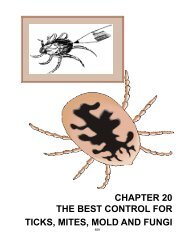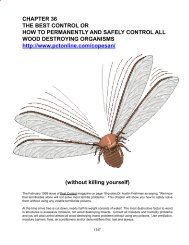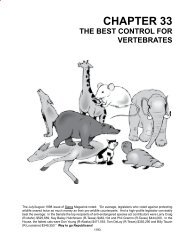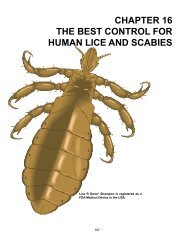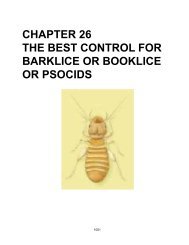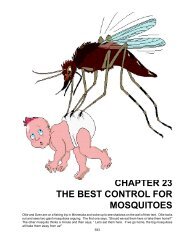CHAPTER 11 - The Best Control 2
CHAPTER 11 - The Best Control 2
CHAPTER 11 - The Best Control 2
- No tags were found...
You also want an ePaper? Increase the reach of your titles
YUMPU automatically turns print PDFs into web optimized ePapers that Google loves.
Xanthorrhoea hastilis R. Br. (Black-boy tree).An Australian patent recommends washing sheep with mixture of 100 parts oil obtained by destructivedistillation of black-boy or yacca-gummi, and 50 parts of fish oil.Ximenia americana L. (X. inermis L.; X. spinosa Salisb.; tallow-nut; tallowwood).Applied to sores of domestic animals to keep off flies.Zanthoxylum americanum Mill. (Prickly-ash).Exts. from dried bark were repellent to Japanese beetle; acetone ext. of berries 60% T mosquito larvae.Zanthoxylum clava-herculis L. (Z. carolinianum Lam.; Z. frazinifolium Walt.; Z. tricarpum Michx.;Fagara clava-herculis Small; hercules-club).Acetone ext. of bark T mosquito larvae; HT houseflies; powdered leaves obnoxious to cotton caterpillars.Zanthoxylum hamiltoniamum Wall. (Tez-moora).Roots used as fish poison; boiled fresh solution of roots T mosquito larvae.Zea mays L. (Indian corn).T downy mildew of hops. 1051.Zea mays L. (Maize or corn oil).Oil T Sphaerotheca humuli at 1%.Zingiber officinale. (Jamaica ginger).Acetone ext. of root T mosquito larvae; oil MT Lucilia cuprina larvae.Note: Virtually all plants produce chemicals insects do not like. In 1964 Gardening without Pesticides by BeatriceTrum Hunter noted: “<strong>The</strong>re are more than three thousand known species of plants which have insecticidalproperties. While there have been plants used for pest control for centuries, that does not guarantee they aresafe. Plants contain many toxins, some of which can harm non-target species like people and/or animals. Evenso, most plants are toxic to mammals only when ingested.In January 2001 the FDA office in Washington, DC threw out the 1948 catalogue which listed the abovementionedplants. <strong>The</strong> Author would like to point out that there are many safe and effective alternativesin the partial list to the dangerous, volatile pediculicides, e.g., pyrethrin, pipernoyl butoxide, permethrin,lindane and/or malathion. Obviously, FDA knew for over 50 years there were safer, more effective alternativesfor lice and other pest problems and did nothing to promote their use. All he can ask is, “Why?”Plant Flowers - This will help encourage many beneficial insects, e.g., flower flies and parasitid wasps.Plant Oils - e.g., mint oil, pine oil, caraway oil, act as an insecticides, acarcides, fungicides and sprout inhibitors;they work because they are neurotoxic to insects, targeting octopamine receptors in their brains, so theinsects become hyperactive, erratic, stop eating and/or convulse. People and animals do not have receptorsor a system octopamine, so most plant oils do not harm most of us.Plant Resistance - Pick a variety of plant that not only is a native species but resistant to disease and pest attackand then keep it healthy.Plantain (Common) (Plaintago major) - Use the bruised/chewed leaves to relieve the itch, burn and/or painof bee, wasp and hornet stings, stinging nettle and poison ivy. You can also chew up some leaves and placethem around a toothache to alleviate pain. Chewing a leaf also may stop the effects of a bee sting or a splinter.A plantain oil infusion is a handy aid to have when suffering from hemorrhoids, bruising, splinters or minor woundsbecause of its ability to staunch blood flow, soothe and repair damaged tissue. If you want to make an oil to usefor salve, pick some fresh leaves and either hang in a breezy spot out of the direct sun, or place on a screen todry. Turn daily until moisture is gone. Place crushed leaves in a clean jar and cover with oil. Most oils are suitablefor ointments and salves. Olive or sesame oils are well suited for skin products and readily available. <strong>The</strong>n youget to be a medicine maker extraordinaire. Strain your infused oil into a large glass measuring cup. For eachcup of oil you will need ¼ c. grated beeswax and 1 T. vitamin E oil as a preservative and skin enhancer. Placeyour measuring cup in shallow water in a pan and heat gently. Add the grated beeswax, stirring until melted. Stirin the vitamin E oil after removing from heat. Wipe all water off cup before pouring into sterilized containers foryour salve. Allow to cool before capping, then label, date and voila - your wild foods garden medicine is made.Congratulations on your dedication to your own natural healing.443



